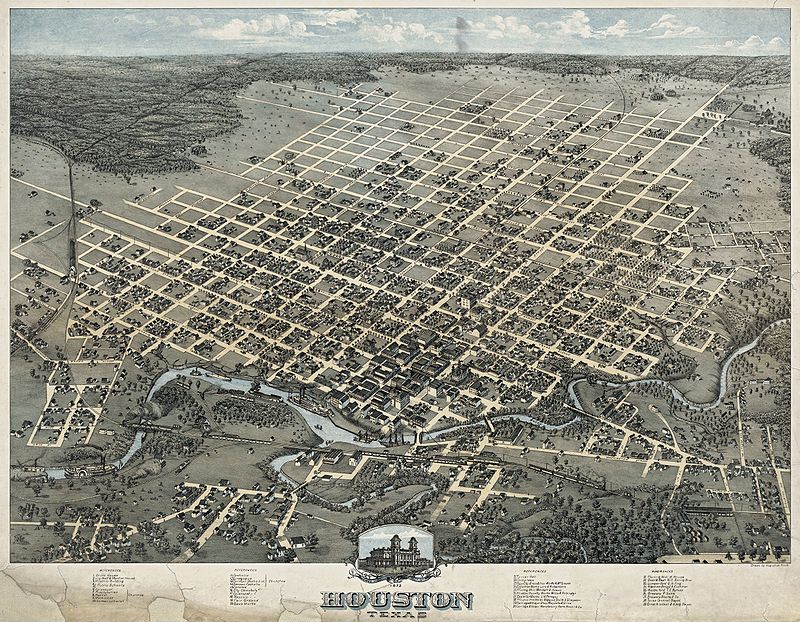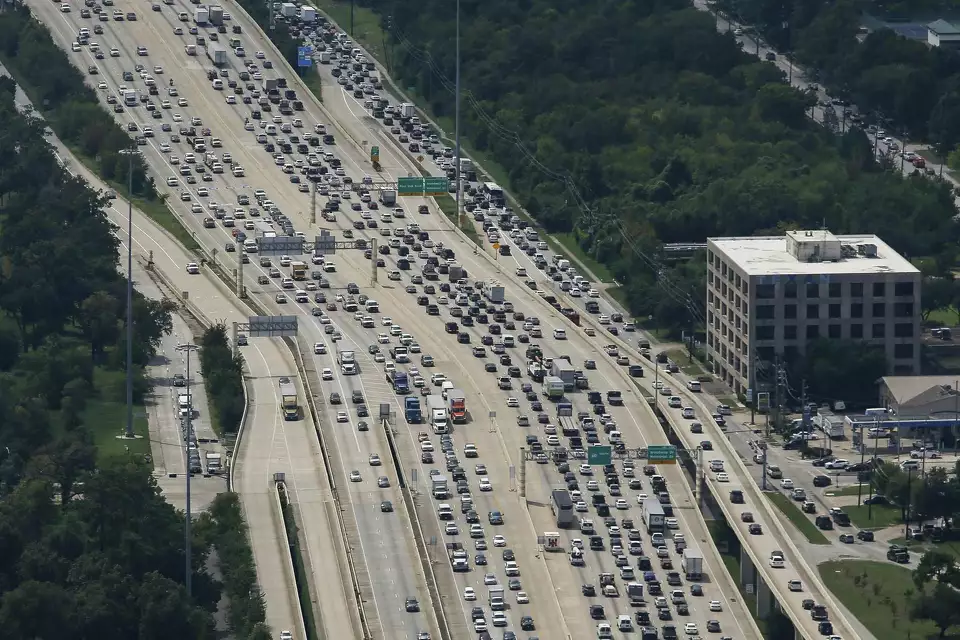Houston is a city like no other in the United States. Known for its dynamic economy, cultural diversity, and rapid growth, it has also gained national attention for its unique approach to urban planning—or the lack thereof. Unlike most major American cities, Houston has no formal zoning laws or comprehensive plans, a characteristic that has shaped its development in profound ways. As we prepare for our upcoming forum, “Planning for Houston’s Future,” understanding Houston’s planning history is essential to contextualize its present and anticipate where it is going.
 The Early Years: Foundations of Houston’s Urban Form
The Early Years: Foundations of Houston’s Urban Form
Founded in 1836 by the Allen brothers, Houston quickly became a commercial hub due to its strategic location near the Gulf of Mexico and its access to railway networks. In its early years, the city’s growth was largely organic, driven by market forces. After the 1901 Galveston Hurricane, the costliest disaster in US history, caused the population to shift inland, and as investment into transportation infrastructure, disaster preparedness, and the Port of Houston were realized. This event created the major economic center of the south, while the urban environment sprawled in growth often following the roadway networks throughout the region. By the late 19th century, Houston had developed into a key center for trade and industry, particularly with the rise of oil and shipping in the early 20th century. Today, Houston is known for energy, healthcare, and technology.
During this period, the City of Houston’s land use patterns were shaped by private investment rather than municipal regulation. Real estate developers played a crucial role in designing communities, often implementing deed restrictions that governed land use in specific neighborhoods. This reliance on private governance instead of public zoning laws remains a defining characteristic of Houston’s planning landscape today.
The Debate Over Zoning: Three Failed Attempts
As Houston grew in the 20th century, debates over zoning became increasingly prominent. Unlike most American cities, Houston resisted the implementation of zoning regulations, instead relying on a mix of deed restrictions, building codes, and infrastructure planning to shape development.
Houston voters rejected zoning ordinances in 1948, 1962, and 1993. The failure of these initiatives can be attributed to several factors, including concerns over property rights, a culture of economic libertarianism, and strong opposition from various stakeholder groups, including developers and certain community organizations. The 1993 referendum, which was the closest of the three, reflected a divided public opinion on whether zoning would enhance or hinder Houston’s flexibility and economic dynamism.
Despite the absence of zoning, Houston has employed various regulatory tools to manage growth. For instance, the city’s land-use regulations include minimum lot sizes, setback requirements, and parking mandates. Additionally, local authorities have leveraged infrastructure investments and neighborhood deed restrictions to influence urban development without imposing a formal zoning framework.
Infrastructure-Driven Growth: The Role of Transportation and Flood Management
Houston’s planning history has been heavily influenced by its approach to infrastructure development. The city’s commitment to highway expansion, particularly from the mid-20th century onward, facilitated extensive suburbanization. Major infrastructure projects such as the construction of Interstate 10, U.S. Route 59, and Loop 610 enabled the city’s outward expansion, reinforcing a car-centric urban form.
enabled the city’s outward expansion, reinforcing a car-centric urban form.
However, Houston’s rapid growth and sprawling development have presented challenges. Situated in a flat, flood-prone region, the city has faced numerous catastrophic flooding events, including Tropical Storm Allison (2001), Hurricane Ike (2008), and Hurricane Harvey (2017). These disasters have highlighted the need for more comprehensive flood mitigation planning in balancing growth with resilience.
Meanwhile, the city’s extensive road network, while facilitating economic growth, has also led to significant traffic congestion. Investment for parks and open space, shopping, dining, gathering, and flexible or office work areas are concentrated along roadway corridors rather than in clustered environments with dedicated open space. This setup limits opportunities for social interaction among diverse age groups and income levels within one space. . As the city continues to expand, and approaches an aging population, the need for investments in public transportation, walkability, and alternative mobility solutions has become more urgent. Additionally, the management of water supply, wastewater treatment, and energy distribution plays a critical role in sustaining Houston’s growth. The demand for improved infrastructure in these areas has led to discussions on how to integrate more sustainable and resilient urban planning practices while maintaining Houston’s flexible development environment.
The Evolution of Houston’s Planning Institutions
While Houston does not have traditional zoning, it has developed institutions to guide urban planning and development. The Houston Planning Commission, established in 1940, plays a crucial role in overseeing land-use policies, platting requirements, and infrastructure planning. The adoption of the city’s first General Plan in 2015, known as Plan Houston, marked a significant step toward a more coordinated approach to urban planning.
Plan Houston outlines a vision for a more connected, resilient, and prosperous city, emphasizing strategies such as transit-oriented development, flood risk reduction, and improved public spaces. Other notable initiatives include the Walkable Places Ordinance and the Transit-Oriented Development Ordinance, both of which aim to encourage pedestrian-friendly and mixed-use development in key urban corridors.
Contemporary Challenges and Opportunities
Even though the Houston economy has remained strong, the coronavirus pandemic in 2019 led to more of the population moving into Fort Bend and Montgomery Counties than remaining in the metro areas, driven by remote work and lifestyle changes. As Houston looks toward the future, it faces several critical planning challenges. These include:
- Resilience and Climate Adaptation: With increasing climate risks, Houston must prioritize investments in flood control, green infrastructure, and climate resilience to protect its residents and economy.
- Mobility and Transportation: While highways have been the backbone of Houston’s growth, there is growing recognition of the need for multimodal transportation options, including expanded METRO services, bike lanes, and pedestrian infrastructure.
- Affordable Housing and Equity: Houston’s lack of zoning has led to diverse housing options, but affordability remains a pressing concern. Addressing displacement, gentrification, and equitable access to services will be key to sustainable growth.
- Economic Diversification and Land Use: While Houston’s economy has historically been tied to energy and real estate, diversifying its economic base through innovation districts and mixed-use developments can enhance long-term prosperity.
- Infrastructure Development. The growing population must be supported by necessary infrastructure such as roads, public transportation, water supply and sewage systems to support the growing population.
- Conduct Quality of Life Assessments: Engaging the public in quality-of-life assessments can help determine whether residents and businesses are receiving an inclusive, innovative physical environment that integrates social, cultural, and economic aspects in each development.
Conclusion

Houston’s planning history is a fascinating case study in market-driven urban development, infrastructure-led growth, and resilience challenges. As we engage in discussions at the “Planning for Houston’s Future” forum, understanding this history will provide a valuable foundation for shaping a forward-thinking approach to sustainable, equitable, and resilient urban development.
Whether Houston ultimately embraces a more structured planning framework or continues to rely on its distinctive blend of regulations and market forces, the choices made today will define the city’s trajectory for decades to come. By learning from the past and embracing innovation, Houston has the opportunity to lead as a model for dynamic, adaptive urban development in the 21st century.
